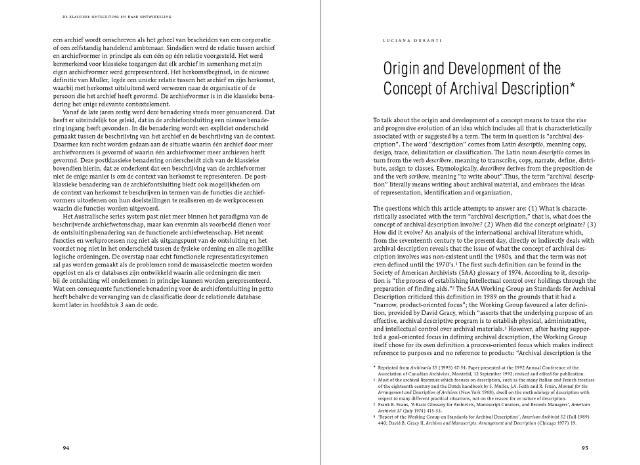Origin and Development of the
Concept of Archival Description*
een archief wordt omschreven als het geheel van bescheiden van een corporatie
of een zelfstandig handelend ambtenaar. Sindsdien werd de relatie tussen archief
en archiefvormer in principe als een één op één relatie voorgesteld. Het werd
kenmerkend voor klassieke toegangen dat elk archief in samenhang met zijn
eigen archiefvormer werd gerepresenteerd. Het herkomstbeginsel, in de nieuwe
definitie van Muller, legde een unieke relatie tussen het archief en zijn herkomst,
waarbij met herkomst uitsluitend werd verwezen naar de organisatie of de
persoon die het archief heeft gevormd. De archiefvormer is in die klassieke bena
dering het enige relevante contextelement.
Vanaf de late jaren zestig werd deze benadering steeds meer genuanceerd. Dat
heeft er uiteindelijk toe geleid, dat in de archiefontsluiting een nieuwe benade
ring ingang heeft gevonden. In die benadering wordt een expliciet onderscheid
gemaakt tussen de beschrijving van het archief en de beschrijving van de context.
Daarmee kan recht worden gedaan aan de situatie waarin één archief door meer
archiefvormers is gevormd of waarin één archiefvormer meer archieven heeft
gevormd. Deze postklassieke benadering onderscheidt zich van de klassieke
bovendien hierin, dat ze onderkent dat een beschrijving van de archiefvormer
niet de enige manier is om de context van herkomst te representeren. De post
klassieke benadering van de archiefontsluiting biedt ook mogelijkheden om
de context van herkomst te beschrijven in termen van de functies die archief
vormers uitoefenen om hun doelstellingen te realiseren en de werkprocessen
waarin die functies worden uitgevoerd.
Het Australische series system past niet meer binnen het paradigma van de
beschrijvende archiefwetenschap, maar kan evenmin als voorbeeld dienen voor
de ontsluitingsbenadering van de functionele archiefwetenschap. Het neemt
functies en werkprocessen nog niet als uitgangspunt van de ontsluiting en het
voorziet nog niet in het onderscheid tussen de fysieke ordening en alle mogelijke
logische ordeningen. De overstap naar echt functionele representatiesystemen
zal pas worden gemaakt als de problemen rond de massaselectie moeten worden
opgelost en als er databases zijn ontwikkeld waarin alle ordeningen die men
bij de ontsluiting wil onderkennen in principe kunnen worden gerepresenteerd.
Wat een consequente functionele benadering voor de archiefontsluiting in petto
heeft behalve de vervanging van de classificatie door de relationele database
komt later in hoofdstuk 3 aan de orde.
To talk about the origin and development of a concept means to trace the rise
and progressive evolution of an idea which includes all that is characteristically
associated with or suggested by a term. The term in question is "archival des
cription". The word "description" comes from Latin descriptio, meaning copy,
design, trace, delimitation or classification. The Latin noun descriptio comes in
turn from the verb describere, meaning to transcribe, copy, narrate, define, distri
bute, assign to classes, Etymologically, describere derives from the preposition de
and the verb scribere, meaning "to write about".Thus, the term "archival descrip
tion" literally means writing about archival material, and embraces the ideas
of representation, identification and organization,
The questions which this article attempts to answer are: (1) What is characte
ristically associated with the term "archival description," that is, what does the
concept of archival description involve? (2) When did the concept originate? (3)
How did it evolve? An analysis of the international archival literature which,
from the seventeenth century to the present day, directly or indirectly deals with
archival description reveals that the issue of what the concept of archival des
cription involves was non-existent until the 1980s, and that the term was not
even defined until the 1970's.1 The first such definition can be found in the
Society of American Archivists (SAA) glossary of 1974. According to it, descrip
tion is "the process of establishing intellectual control over holdings through the
preparation of finding aids."2 The SAA Working Group an Standards for Archival
Description criticized this definition in 1989 on the grounds that it had a
"narrow, product-oriented focus"; the Working Group favoured a later defini
tion, provided by David Gracy, which "asserts that the underlying purpose of an
effective, archival descriptive program is to establish physical, administrative,
and intellectual control over archival materials.3 However, after having suppor
ted a goal-oriented focus in defining archival description, the Working Group
itself chose for its own definition a process-oriented focus which makes indirect
reference to purposes and no reference to products: "Archival description is the
DE KLASSIEKE ONTSLUITING EN HAAR ONTWIKKELING
94
LUCIANA DURANTI
Reprinted from Archivaria 35 (1993) 47-54. Paper presented at the 1992 Annual Conference of the
Association of Canadian Archivists, Montreal, 12 September 1992; revised and edited for publication.
1 Most of the archival literature which focuses on description, such as the many Italian and French treatises
of the eighteenth century and the Dutch handbook by S. Muller, J.A. Feith and R. Fruin, Manual for the
Arrangement and Description of Archives (New York 1968), dwell on the methodology of description with
respect to many different practical situations, not on the reason for or nature of description.
2 Frank B. Evans, A Basic Glossary for Archivists, Manuscript Curators, and Records Managers', American
Archivist 37 (July 1974 415-33.
3 'Report of the Working Group on Standards for Archival Description', American Archivist 52 (Fall 1989)
440; David B. Gracy II, Archives and Manuscripts: Arrangement and Description (Chicago 1977) 19.
95

